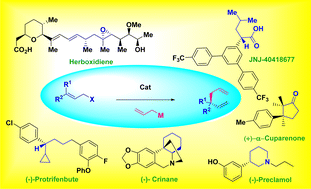Recent development of allyl–allyl cross-coupling and its application in natural product synthesis
Abstract
The allyl–allyl cross-coupling reaction is one of the most important cross-coupling reactions as it provides a practical synthetic route for the direct construction of 1,5-dienes, which are abundant in terpenes, and are significant building blocks in chemical synthesis. The transition metal-catalyzed cross-coupling has the power to generate synthetically important 1,5-dienes from an allylic nucleophile and allylic electrophile. Catalysts derived from different metals, including Pd, Ni, Cu, Ir etc. are extensively studied and show excellent regio- and enantioselective control. Moreover, this strategy has been successfully applied in stereoselective total syntheses of a number of complex natural products. Major developments have been observed over the past decade in the allyl–allyl cross-coupling strategy, and the application of a new tool for regio-and enantioselective C–C bond formation to form the 1,5-diene has revolutionized synthetic chemistry. The present Short Review summarises the most significant advancements that have provided access to a wide variety of branched/and linear 1,5 dienes of synthetic and pharmaceutical importance during the past decade. To the best of our knowledge, this is the first review on the allyl–allyl cross-coupling reaction.

- This article is part of the themed collection: 2023 Organic Chemistry Frontiers Review-type Articles


 Please wait while we load your content...
Please wait while we load your content...